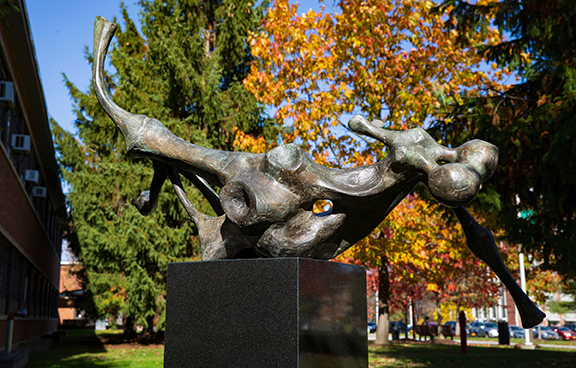Art Museum to honor pioneering faculty member Ed Wilson
‘The Sculptor as Afro-Humanist’ exhibition to open in 2023

Tucked in a shady alcove next to the Fine Arts Building is a sculpture in the warped form of a man plummeting from above, his metal body contorted and bent at the joints. Though many in the Binghamton University campus community have passed “Falling Man’’ since its reinstallation in 2019, few of them know about its creator: Ed Wilson.
When Wilson died in 1997, his loss rippled through the numerous communities he’d devoted himself to: Binghamton University, the broader Binghamton public and a nationwide network of Black artists. He was well known in these groups during his prime, leading a rich life of artistic creation and activism. But awareness of his achievements has faded in recent years.
With the help of a grant from the Terra Foundation for American Art, which fosters intercultural dialogues and encourages transformative practices to expand narratives of American art, the Binghamton University Art Museum is organizing an exhibition titled “Ed Wilson: The Sculptor as Afro-Humanist” to open in September 2023 in the Art Museum. It aims to bring fresh attention to the artist who taught at Binghamton for more than three decades.
With the exhibit, the Art Museum will honor different facets of his life: Wilson as artist, activist, teacher and friend. The exhibition will take a multimedia approach in an effort to highlight Wilson’s personal history and his sculptures. Organizers plan for Wilson’s art to be featured alongside a collection of oral histories told by relatives, friends and community members.
Diane Butler, Art Museum director, and Tom McDonough, professor of art history and exhibit curator, see this as their “last chance” to collect these stories properly, as the generation Wilson taught ages into retirement.
“We’re taking a unique approach to collecting oral histories, not just of people who were his students or colleagues,” Butler says. “We’re casting our net widely to understand the full impact he had on campus and in the broader community.”
The oral histories are an unusual addition to the Art Museum’s exhibition planning process and will showcase the extent of Wilson’s presence beyond his art. Visitors will be able to access excerpts of these stories at the exhibition while viewing his art. Following the exhibition, the interviews will become part of the University Archives and be available to scholars.
Like all exhibitions at the Art Museum, “Ed Wilson” will be free and open to the community, a choice in alignment with Wilson’s commitment to accessible art. He made a point of working on public commissions and making his art available to the widest possible audiences. But because Wilson often embedded his artwork in the community, many of his sculptures did not enjoy the commercial success that galleries can provide. Ironically, due to his commitment to accessibility, his art flew under the radar.
“There’s a paradox with public works. They’re visible, but invisible,” McDonough says. “You walk past a work without thinking about it. This is a chance to draw people’s attention to it: to return it to visibility and preserve those memories.”
By returning public works to visibility, younger generations will have a chance to bring their own interpretations to the art. Though many of these works were created within the context of the civil rights movement, McDonough says they remain relevant in 2023 and to the student audience on campus.
“A new generation of people looking at this work is going to bring a new lens of meaning onto it. It’s part of the joy, part of why we have museums and show this work,” he says. “Each individual who comes to the work is going to bring new insights to it.”
As long as his art continues to be viewed, Wilson’s work will keep provoking the conversations he intended, and move viewers closer to the humanism and deep compassion underlying his artwork, McDonough and Butler say.
“Ed’s work presents both a tough and generous vision of America,” McDonough says. “He raises questions around inclusion, exclusion, and the dark history of race in this country, but at its core, there’s a belief in human possibility.”
To help with the exhibit
Alumni or community members who have any memories, objects or stories pertaining to Ed Wilson may contact the Binghamton University Art Museum or send an email to edwilsonproject@binghamton.edu.
